Healthcare Human Resources: Trends and Demand in Saudi Arabia
Abstract
1. Introduction
1.1. Healthcare Policies of Saudi Arabia
1.2. Research Problem
1.3. Objectives
- To conduct a time-series analysis of national and international health human resources data in order to determine their percentage change in MOH, OGH and PHS;
- To extrapolate the growth of the population of Saudi Arabia until 2030 and, accordingly, project the demand for HHR from 2018 until 2030;
- To understand the drivers of HHR demand and supply in 2015, 2020 and 2030;
- To analyze the results in terms of the impact of Government policies on attracting Saudi nationals to the healthcare sector;
- To offer suggestions in terms of bridging the gap between theory and practice and the impacts on policies and the society.
2. Methodology
2.1. Data Collection
2.2. Data Transformation
2.3. Statistical Tools and Techniques
3. Results and Discussion
3.1. Ministry of Health (MOH) Sector
3.2. Other Government Healthcare (OGH) Sector
3.3. Private Healthcare Sector (PHS)
3.4. Projection of Population and Demand of HHR
3.5. The Supply of Healthcare Human Resources
3.6. Drivers of HHR Demand
3.7. Drivers of Healthcare Human Resources Supply
3.7.1. Inflows
3.7.2. Education
3.7.3. Immigration
3.7.4. Outflows
4. Policy Implications
4.1. Bridging the Gap between Theory and Practice
4.2. Impact on Policy
4.3. Impact on Society
5. Conclusions
Author Contributions
Funding
Institutional Review Board Statement
Data Availability Statement
Acknowledgments
Conflicts of Interest
References
- National Transformation Program 2020, A Program by Vision 2030, Kingdom of Saudi Arabia. Available online: http://vision2030.gov.sa/sites/default/files/NTP_En.pdf (accessed on 21 May 2021).
- Ministry of Health. Saudi Ministry of H. Statistics Book 1436; Ministry of Health: Riyadh, Saudi Arabia, 2015. [Google Scholar]
- Oxford Business Group. The Report: Saudi Arabia 2016; Oxford Business Group: Oxford, UK, 2016. [Google Scholar]
- Standing, H. Gender: A Missing Dimension in Human Resource Policy and Planning for Health Reforms. Hum. Resour. Dev. J. 2000, 4, 27–42. [Google Scholar]
- Cooper, R.A.; Getzen, T.E.; Laud, P. Economic expansion is a major determinant of physician supply and utilization. Health Serv. Res. 2003, 38, 675–696. [Google Scholar] [CrossRef] [PubMed]
- HRSA. Physician Supply and Demand: Projections to 2020. U.S. Department of Health and Human Services, Health Resources and Services Administration, Bureau of Health Professions, Washington. 2006. Available online: http://bhpr.hrsa.gov/healthworkforce/reports/physiciansupplydemand/default.htm (accessed on 13 May 2021).
- Dubois, C.A.; Nolte, E.; McKee, M. Human Resources for Health in Europe; 2005. Available online: http://www.euro.who.int/document/e87923.pdf (accessed on 15 May 2021).
- Brooks, P.M.; Lapsley, H.M.; Butt, D.B. Medical workforce issues in Australia: Tomorrow’s doctors-too few, too far. Med. J. Aust. 2003, 179, 206–208. [Google Scholar] [CrossRef] [PubMed][Green Version]
- Council of Cooperative Health Insurance Rules and Regulations; Kingdom of Saudi Arabia. 1999. Available online: http://gulfmigration.eu/database/legal_module/Saudi%20Arabi/National%20Legal%20Framework/Rights%20and%20Obligations/2.2%20Cooperative%20Health%20Insurance%20Law_EN.pdf (accessed on 1 May 2021).
- Saudi Ministry of Labor Nitaqat Manual. 2013. Available online: http://www.emol.gov.sa/nitaqat/files/manual.pdf (accessed on 1 May 2021).
- Saudize the Healthcare Sector. Available online: https://saudigazette.com.sa/article/535554 (accessed on 1 May 2021).
- Saudi Arabia: Elimination of Yellow Band from Nitaqat Program. Available online: https://www.mondaq.com/saudiarabia/work-visas/873986/elimination-of-yellow-band-from-nitaqat-program (accessed on 1 May 2021).
- Arabnews. Available online: https://www.arabnews.com/node/1813691/business-economy (accessed on 1 May 2021).
- O’Brien-Pallas, L.; Baumann, A.; Donner, G.; Murphy, G.T.; Lochhaas-Gerlach, J.; Luba, M. Forecasting models for human resources in health care. J. Adv. Nurs. 2001, 33, 120–129. [Google Scholar] [CrossRef] [PubMed]
- Buchan, J.; Dal Poz, M.R. Skill mix in the health care workforce: Reviewing the evidence. Bull. World Health Organ. 2002, 80, 575–580. [Google Scholar] [PubMed]
- WHO. The World Health Report 2010: Working Together for Health; World Health Organization: Geneva, Switzerland, 2010. [Google Scholar]
- Dussault, G.; Dubois, C.A. Human resources for health policies: A critical component in health policies. Hum. Resour. Health 2003, 1, 1–16. [Google Scholar] [CrossRef] [PubMed]
- Rudin, R.S.; Fischer, S.H.; Damberg, C.L.; Shi, Y.; Shekelle, P.G.; Xenakis, L.; Khodyakov, D.; Ridgely, M.S. Optimizing health IT to improve health system performance: A work in progress. Heal 2020, 8, 100483. [Google Scholar] [CrossRef] [PubMed]
- Gerding, J.A.; Brooks, B.; Landeen, E.; Whitehead, S.; Kelly, K.R.; Allen, A.; Banaszynski, D.; Dorshorst, M.; Drager, L.; Eshenaur, T.; et al. Identifying Needs for Advancing the Profession and Workforce in Environmental Health. Am. J. Public Heal. 2020, 110, 288–294. [Google Scholar] [CrossRef] [PubMed]
- Al-Anezi, F.M.; Alrajhi, S.; Al-Anezi, N.M.; Alabbadi, D.M.; Almana, R. A review of healthcare system in Saudi Arabia. In Proceedings of the 2020 19th International Symposium on Distributed Computing and Applications for Business Engineering and Science (DCABES), Xuzhou, China, 16 October 2020; pp. 318–322. [Google Scholar]
- WHO. The World Health Report 2000: Health Systems: Improving Performance, Report No.: 92 4 156198 X; World Health Organization: Geneva, Switzerland, 2000. [Google Scholar]
- Bertodano, I. The Costa Rican health system: Low cost, high value. Bull. World Health Organ. 2003, 81, 626–627. [Google Scholar]
- Human Development Report 1995; United Nations Development Programme: New York, NY, USA, 1995.
- Joyce, C.M.; McNeil, J.J.; Stoelwinder, J.U. Time for a new approach to medical workforce planning. Med. J. Aust. 2004, 180, 343–346. [Google Scholar] [CrossRef] [PubMed]
- Darzi, A. A high quality workforce: NHS Next Stage review. Lond. Dep. Health 2008, 1, 1–92. [Google Scholar]
- Goodman, D.C.; Fisher, E.S.; Bubolz, T.A.; Mohr, J.E.; Poage, J.F.; Wennberg, J.E. Benchmarking the US physician workforce. An alternative to needs-based or demand-based planning. JAMA 1996, 276, 1811–1817. [Google Scholar] [CrossRef] [PubMed]
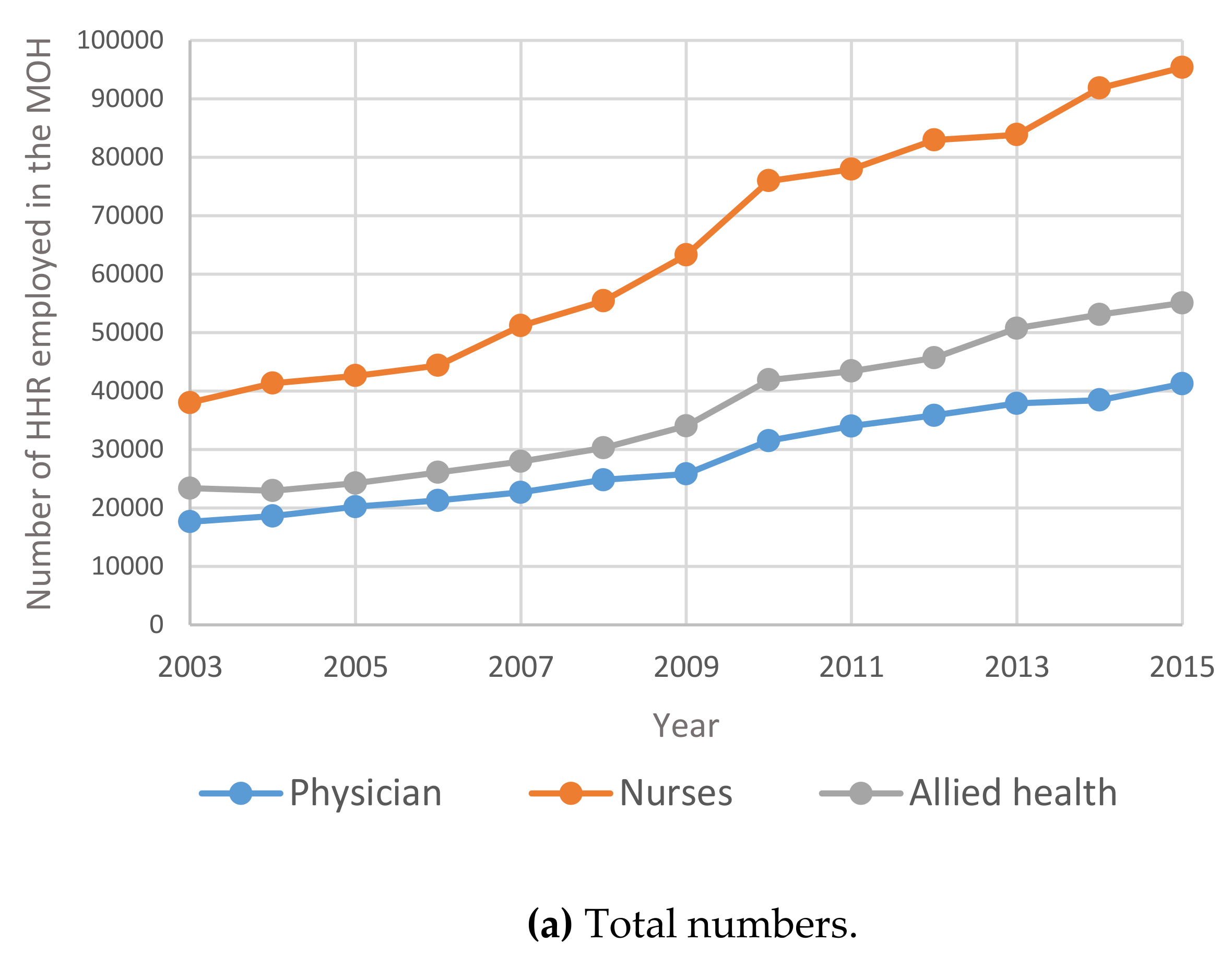

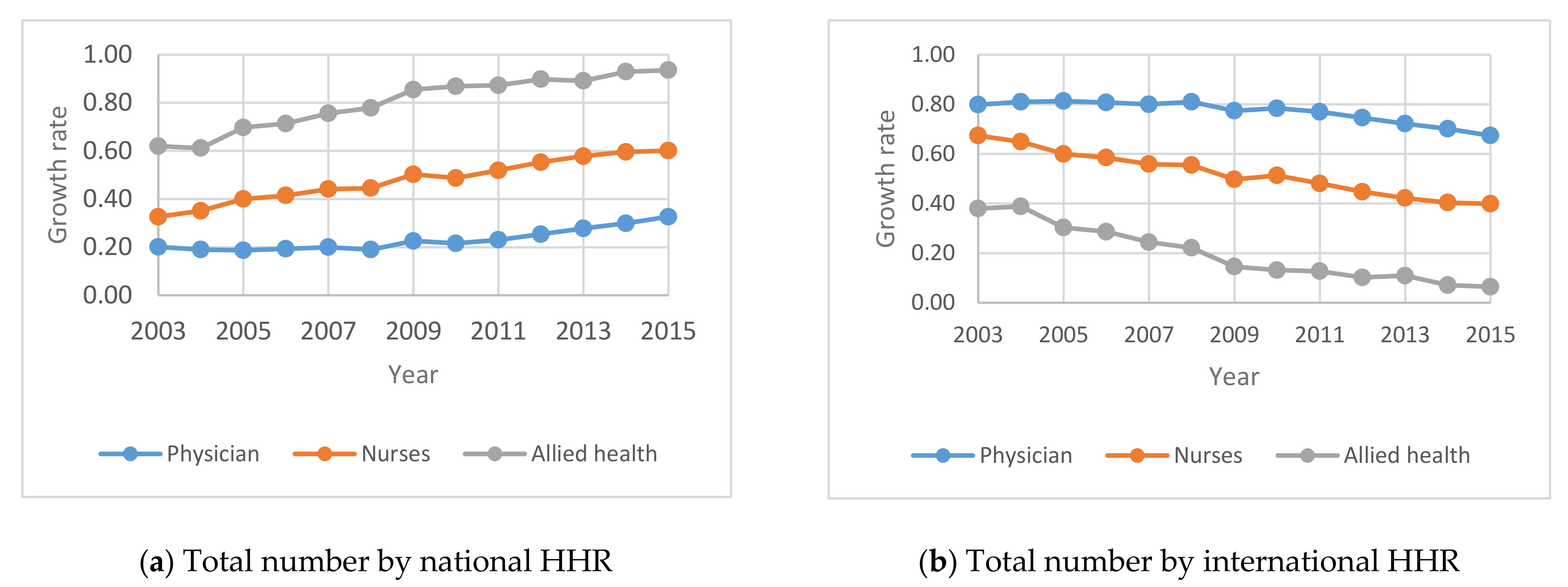
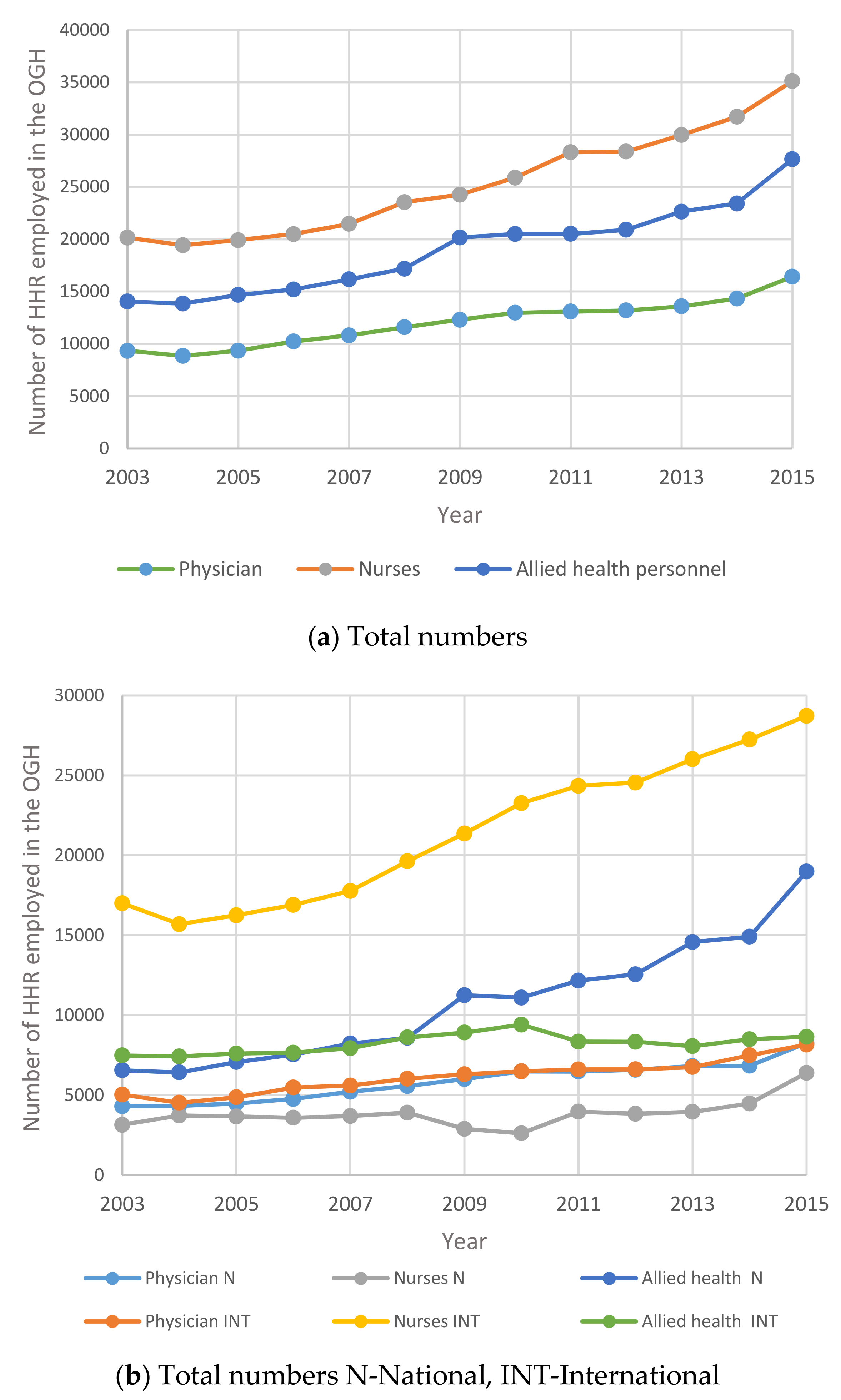
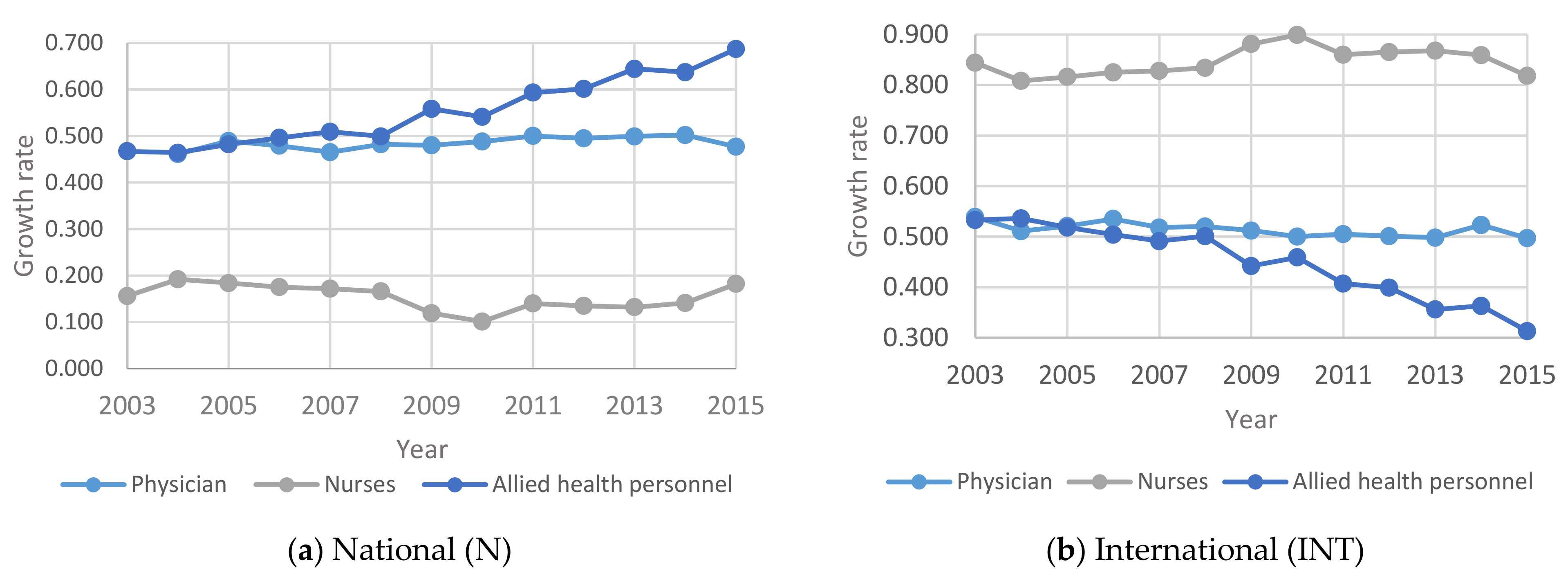
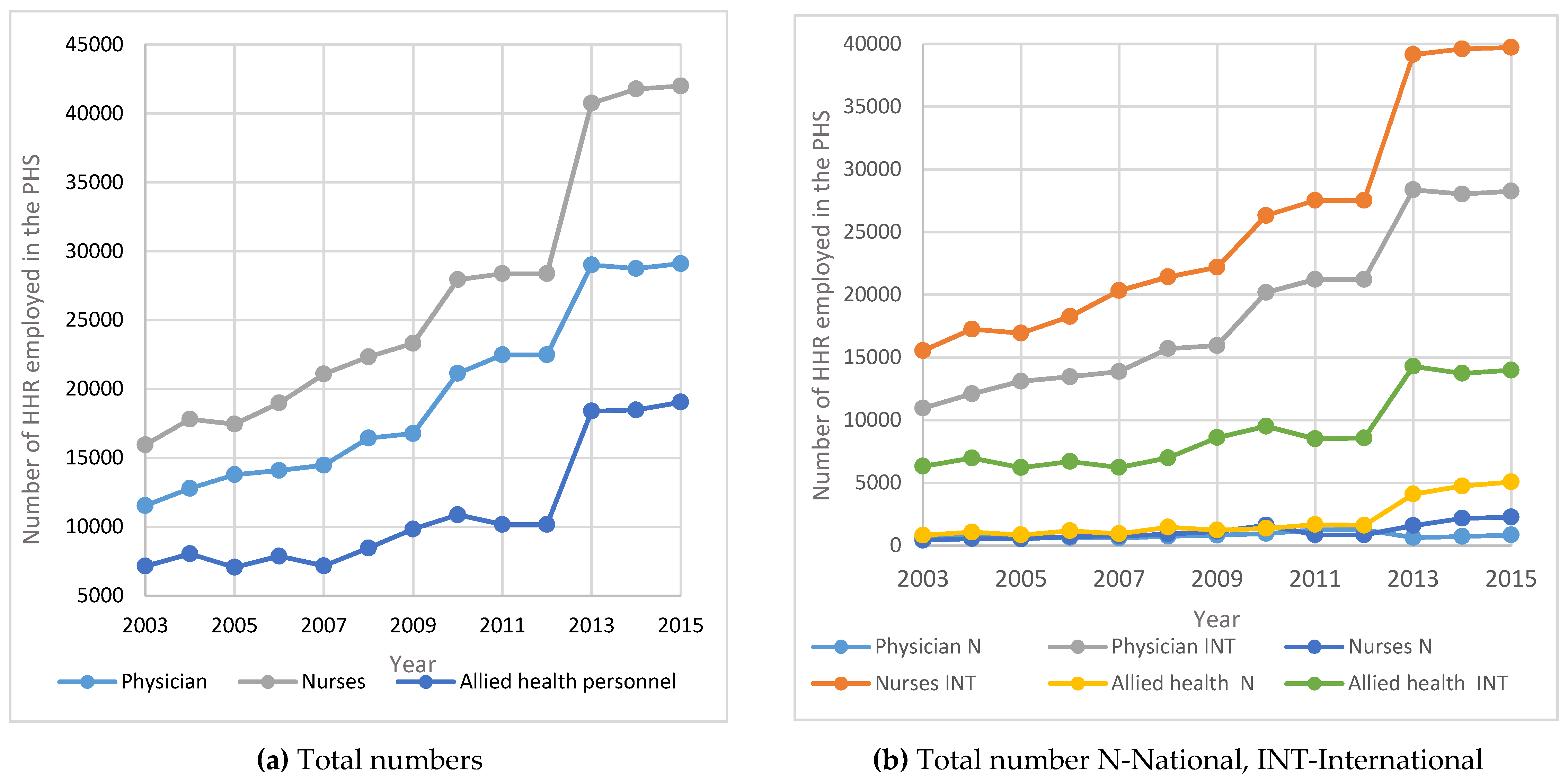
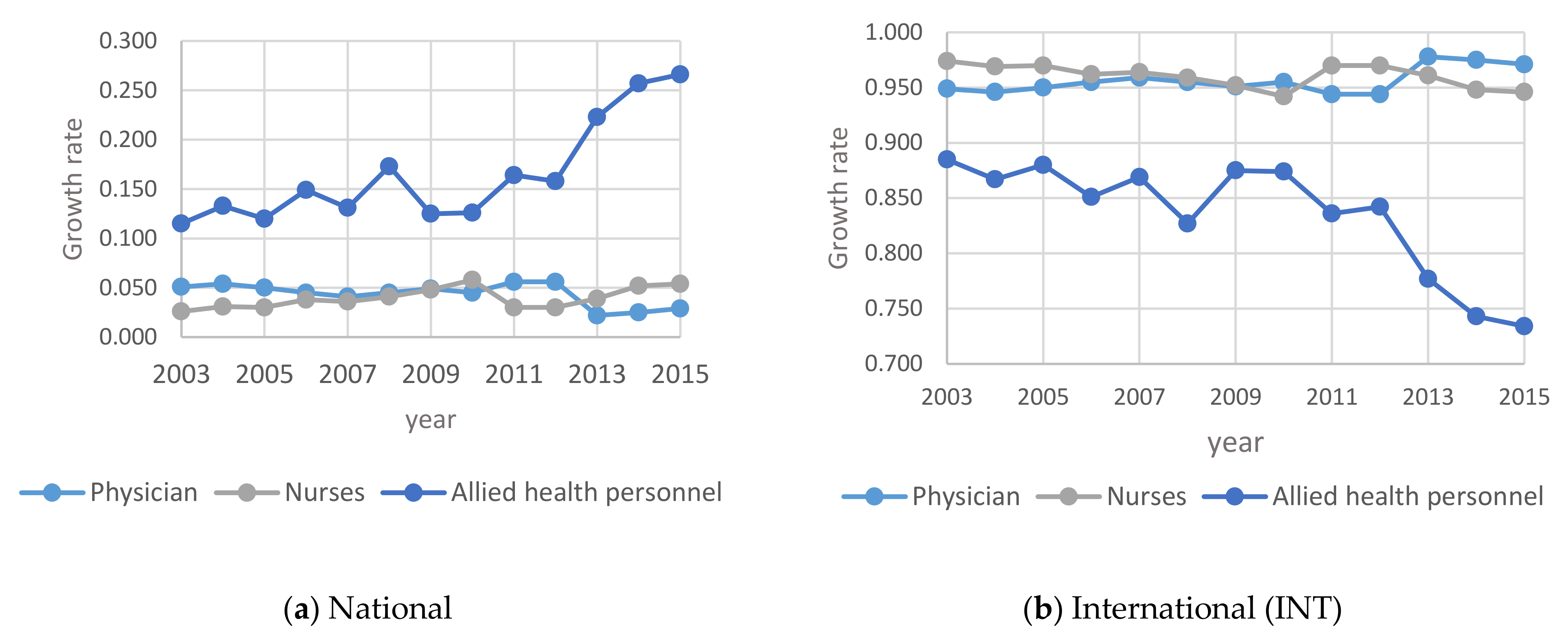
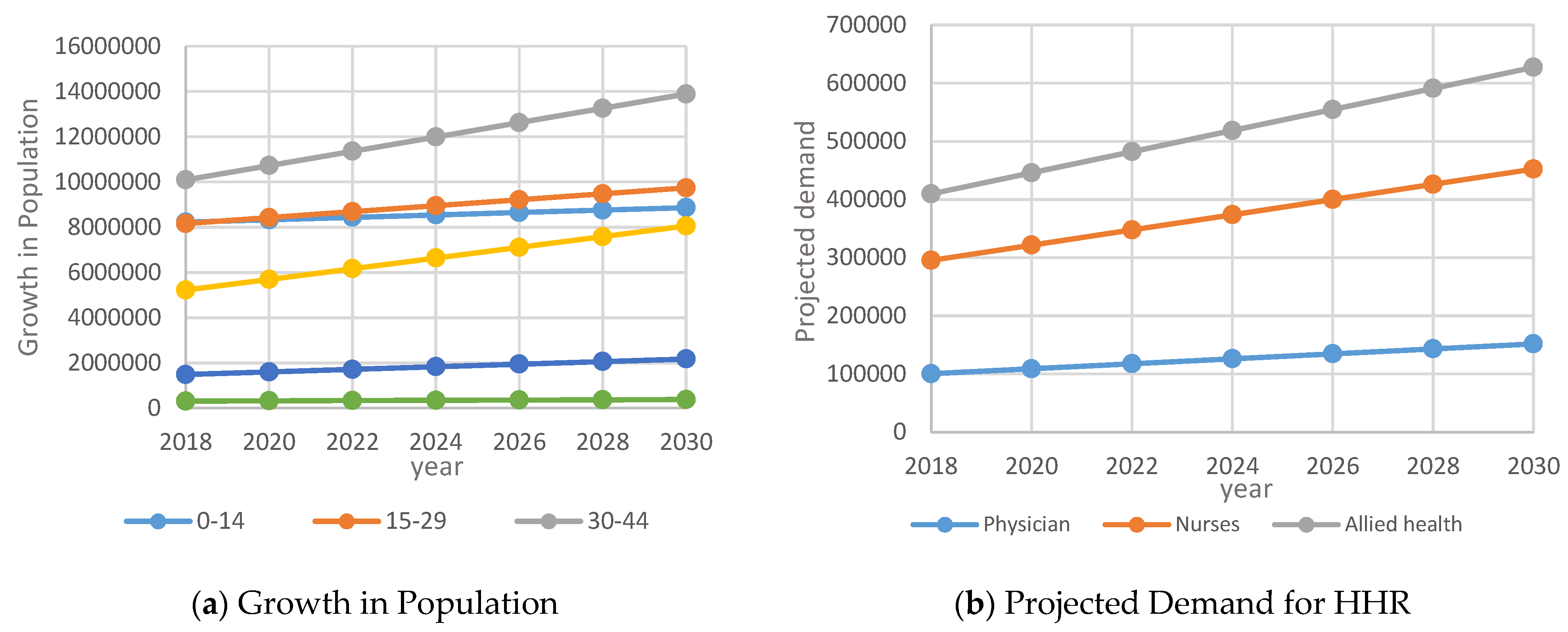
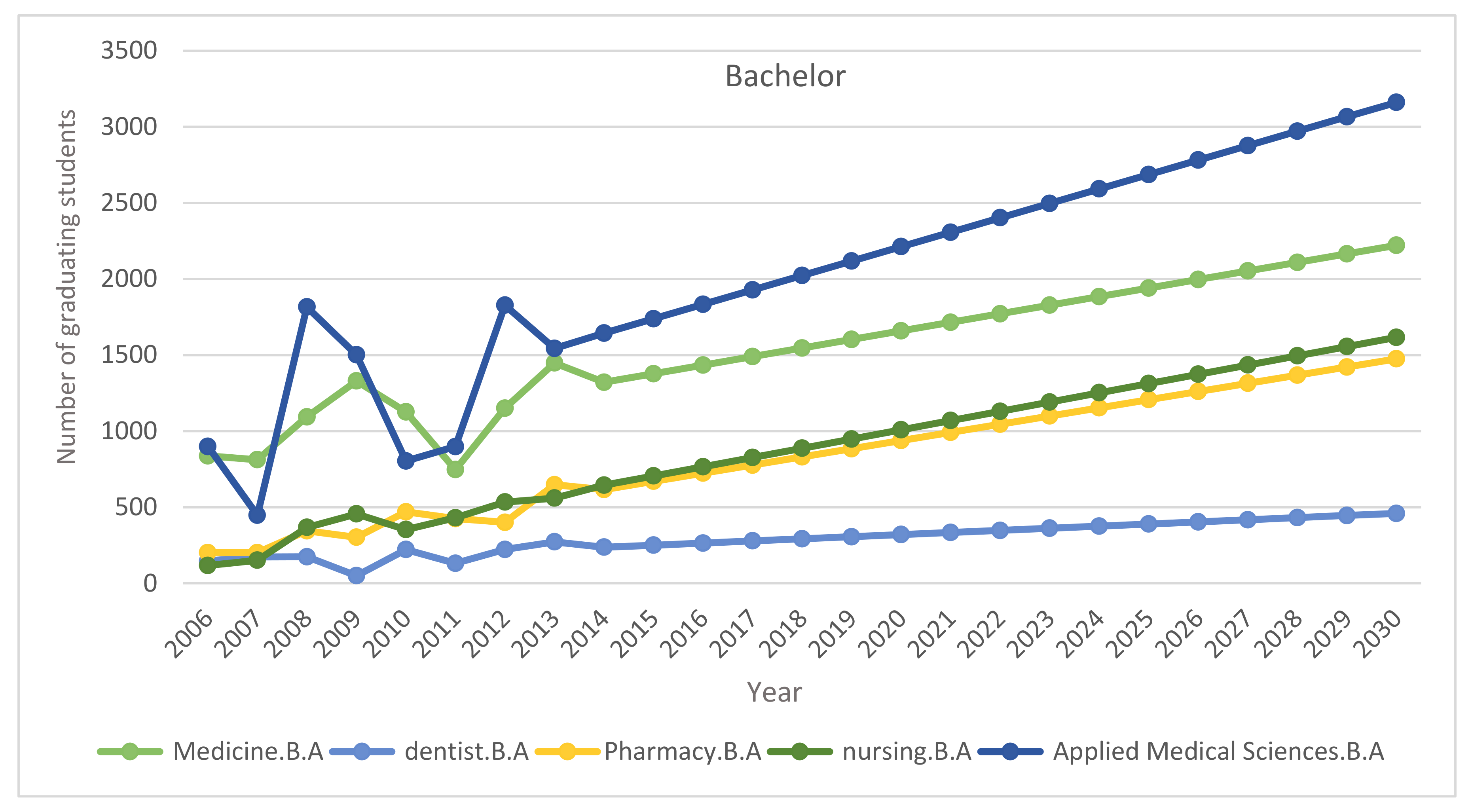
| Sector | Category | Inventory in 2015 with a Population of 31.56 Million | Demand for 2020 with a Population of 35.09 Million | Demand for 2030 with a Population of 43.1 Million | |||
|---|---|---|---|---|---|---|---|
| Saudi (%) | Number | Saudi (%) | Number | Saudi (%) | Number | ||
| Ministry of Health | Physicians | 32.6 | 41,240 | 44.3 | 49,456 | 68.0 | 66,555 |
| Nurses | 60.1 | 95,379 | 71.4 | 117,038 | 92.1 | 160,810 | |
| Pharmacists | 91.8 | 3184 | 105.3 | 4840 | 130.4 | 8174 | |
| Allied health | 93.6 | 55,080 | 101.5 | 71,091 | 117.2 | 101,786 | |
| OGH | Physicians | 50.3 | 16,419 | 49.1 | 19,585 | 48.5 | 27,391 |
| Nurses | 18.2 | 35,119 | 20.9 | 42,559 | 29.9 | 59,503 | |
| Pharmacists | 63.6 | 2132 | 72.78 | 2507 | 88.0 | 3305 | |
| Allied health | 68.7 | 27,647 | 78.9 | 34,767 | 101.3 | 51,547 | |
| Private Sector | Physicians | 2.9 | 29,097 | −2.2 | 40,013 | −10.7 | 59,516 |
| Nurses | 5.4 | 41,985 | 9 | 64,681 | 16 | 105,300 | |
| Pharmacists | 3.7 | 18,308 | 8.2 | 28,646 | 16.5 | 47,779 | |
| Allied health | 26.6 | 19,046 | 42.6 | 33,486 | 72.9 | 59,532 | |
| TOTAL | Physicians | 26.0 | 86,756 | 29.8 | 109,054 | 39.3 | 153,462 |
| Nurses | 38.3 | 172,483 | 46.8 | 224,278 | 63.4 | 325,613 | |
| Pharmacists | 21.0 | 23,624 | 26.0 | 35,993 | 36.1 | 59,258 | |
| Allied health | 74.3 | 101,773 | 82.4 | 139,343 | 99.0 | 212,864 | |
| Sector | Category | 2020 | 2030 | ||||||
|---|---|---|---|---|---|---|---|---|---|
| Supply | Demand | Gap | Graduates Needed as % of Demand-Supply | Supply | Demand | Gap | Graduates Needed as % of Demand-Supply | ||
| Total | Physicians | 9110 | 109,054 | 99,944 | 29.8% | 28,696 | 153,462 | 124,766 | 39.3% |
| Nurses | 6148 | 22,4278 | 218,130 | 46.8% | 22,493 | 325,613 | 303,120 | 63.4% | |
| Pharmacists | 5730 | 35,993 | 30,263 | 26% | 20,773 | 59,258 | 38,485 | 36.1% | |
| Allied health | 15,244 | 139,343 | 124,099 | 82.4% | 52,889 | 212,864 | 159,975 | 99.0% | |
Publisher’s Note: MDPI stays neutral with regard to jurisdictional claims in published maps and institutional affiliations. |
© 2021 by the authors. Licensee MDPI, Basel, Switzerland. This article is an open access article distributed under the terms and conditions of the Creative Commons Attribution (CC BY) license (https://creativecommons.org/licenses/by/4.0/).
Share and Cite
Alnowibet, K.; Abduljabbar, A.; Ahmad, S.; Alqasem, L.; Alrajeh, N.; Guiso, L.; Zaindin, M.; Varanasi, M. Healthcare Human Resources: Trends and Demand in Saudi Arabia. Healthcare 2021, 9, 955. https://doi.org/10.3390/healthcare9080955
Alnowibet K, Abduljabbar A, Ahmad S, Alqasem L, Alrajeh N, Guiso L, Zaindin M, Varanasi M. Healthcare Human Resources: Trends and Demand in Saudi Arabia. Healthcare. 2021; 9(8):955. https://doi.org/10.3390/healthcare9080955
Chicago/Turabian StyleAlnowibet, Khalid, Adel Abduljabbar, Shafiq Ahmad, Latifah Alqasem, Nabil Alrajeh, Luigi Guiso, Mazin Zaindin, and Madhusudhan Varanasi. 2021. "Healthcare Human Resources: Trends and Demand in Saudi Arabia" Healthcare 9, no. 8: 955. https://doi.org/10.3390/healthcare9080955
APA StyleAlnowibet, K., Abduljabbar, A., Ahmad, S., Alqasem, L., Alrajeh, N., Guiso, L., Zaindin, M., & Varanasi, M. (2021). Healthcare Human Resources: Trends and Demand in Saudi Arabia. Healthcare, 9(8), 955. https://doi.org/10.3390/healthcare9080955







